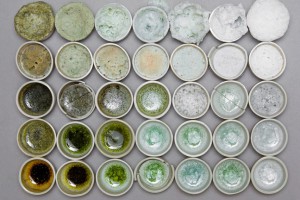INTRODUCTION TO ATELIER NL
Atelier NL is run by two women Nadine Sterk and Lonny van Ryswyck. They are Design Academy Eindhoven graduates whose design studio is also based in an old church in Eindhoven. This year they were selected as the official Dutch Design week ambassadors, alongside architect Winy Maas of MVRDV and Dezeen founder Marcus Fairs.
Since 2010, the women have been running their ground based practice of collecting samples of sand from dunes, beaches, rivers, mountains and quarries to melt it into glass. One of the aims of the project To See a World in a Grain of Sand is to “reveal the unique colors and textures of the world and share the origins and stories of both sand and people from all corners of the globe”. This is made possible by the submission contributed by the public in response to the open call for sand samples.
The project also draws attention to the massively underestimated resource sand and the fact that the worldwide stocks of white sand are running out. Personally I haven’t really given much thought to this issue before which is why I wanted to look further into it, even though Atelier NL’s work and research that takes a part in the exhibition Change the System in museum Boijmans in Rotterdam seems to be highlighting more of the social aspect as it perhaps makes it more approachable and appealing to a larger audience.
In the future local supplies of sand might become an important source for the industry that, unlike the small Dutch design studio, is not yet able to process this natural sand. Besides glass, sand is also vital for many other industries including the manufacturing of computer chips and construction of buildings.
SAND – A FINITE RESOURCE
To put it simply sand is one of the main ingredients of modern life. Besides water and air, sand is the most used natural resource. We need concrete and asphalt to build cities roads, and sand is used for both of them. Not to forget windows, glasses, plates, cellphone screens and filtration systems in water treatment facilities, septic systems and swimming pools.
So cities are basically made out of sand, and since 1950 the number of people living in the cities has grown from 746 million to almost 4 billion making the demand of sand so high that we are now starting to run out of this natural resource.
Both legal and illegal trade have economic and ecological backlash. It is estimated that 70% of the world’s beaches are disappearing due to these practices. Mining sand in rivers, beaches or offshore will inexorably lead to the disappearance of our beaches.
In Indonesia around two dozen small islands have vanished since 2005 because of sand mining. The coral reefs in Kenya, hundreds of acres of forest in Vietnam, and the ecosystem of India’s rivers have suffered the damages of sand trade as well. People working in the industry are getting hurt too, and some of the activists and government official confronting the black market sand mining gangs end up killed.
Stronger regulations are able to prevent some of the damages. The downside of this is that sand is heavy and expensive to transport which could cause the price go up in many developed countries where the sand mining gets banned for environmental reasons. If the sand needs to be trucked from further away, the price will go up as well. This would eventually hit the economy hard and cause more pollution and extra truck traffic.
Despite the effort, the attempts to stop the illegal mining doesn’t always work. An example of this are the satellite images released in 2012 by an environmental organization called Global Witness that showed how Singapore had expanded its land area by 22% over the past 50 years. The sand used in the process came mostly from surrounding countries like Vietnam, Malaysia and Indonesia, and had in some cases been extracted illegally.
These countries then responded by banning sand mining. After the ban in other countries, Singapore’s demand for sand continued fueling the industry in Cambodia, even though the government official claim to even have ban the mining in some cases.
In a way sand could be called the new oil. There are not yet good alternatives as the desert sand, shaped more by wind rather than water, and the local supplies of sand are not suitable for the needs of the industry. To find a solution for the shortage of sand won’t be an easy task but in the meantime more focus should be put on how we are using the still remaining resources.

